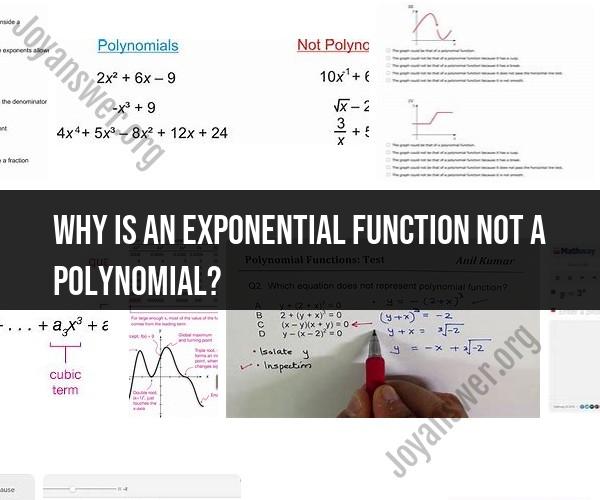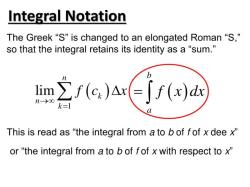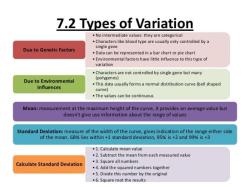Why is an exponential function not a polynomial?
An exponential function is not a polynomial because it has a fundamentally different mathematical form and behavior. The key difference between exponential functions and polynomials lies in their exponents and how they grow as their input values (usually denoted as "x") become large or small.
Exponential Functions:
- An exponential function has the general form: f(x) = a * b^x, where "a" and "b" are constants, and "b" is usually greater than 1 (for exponential growth) or between 0 and 1 (for exponential decay).
- The exponent "x" is typically a variable that can take on any real number.
- As "x" becomes larger, the value of the exponential function grows or decays rapidly, depending on the value of "b." The rate of growth or decay is determined by the magnitude of "b."
Polynomials:
- A polynomial function has the general form: f(x) = a_n * x^n + a_(n-1) * x^(n-1) + ... + a_1 * x + a_0, where "a_0," "a_1," ..., "a_n" are constants, and "n" is a non-negative integer.
- The exponent in a polynomial is always a non-negative integer, and the highest power of "x" in the polynomial determines its degree. For example, if the highest power is 3, it's a cubic polynomial.
- Polynomials grow or decay at a slower, more predictable rate as "x" becomes large or small, depending on the degree of the polynomial.
In summary, the critical distinction is that exponential functions involve real number exponents and exhibit rapid growth or decay as "x" varies, while polynomials have integer exponents and grow or decay at a more controlled and predictable rate. This fundamental difference in behavior and form distinguishes exponential functions from polynomials in mathematics.
Exponential vs. Polynomial: Why Exponential Functions Differ
Exponential and polynomial functions are two different types of mathematical functions. Polynomial functions are functions in which the variable is raised to a non-negative integer power. Exponential functions are functions in which the variable is the exponent.
One of the key differences between exponential and polynomial functions is their growth rate. Polynomial functions grow at a polynomial rate, which means that the rate of growth increases as the variable increases. Exponential functions grow at an exponential rate, which means that the rate of growth increases exponentially as the variable increases.
For example, the polynomial function f(x) = x^2 grows at a polynomial rate. This means that as x increases, the value of f(x) increases at an increasing rate. However, the exponential function g(x) = 2^x grows at an exponential rate. This means that as x increases, the value of g(x) increases at an increasingly faster rate.
Another key difference between exponential and polynomial functions is their end behavior. Polynomial functions have a finite degree, which means that their end behavior is determined by the highest power of the variable in the function. Exponential functions, on the other hand, have an infinite degree, which means that their end behavior is determined by the base of the function.
For example, the polynomial function f(x) = x^2 has a finite degree of 2. This means that as x approaches positive or negative infinity, the value of f(x) approaches positive infinity. The exponential function g(x) = 2^x has an infinite degree. This means that as x approaches positive infinity, the value of g(x) approaches positive infinity. However, as x approaches negative infinity, the value of g(x) approaches zero.
Understanding the Nature of Exponential Functions and Polynomials
Exponential functions and polynomials are both important mathematical functions with a wide range of applications. Exponential functions are used to model phenomena such as population growth, radioactive decay, and compound interest. Polynomial functions are used to model phenomena such as the motion of a projectile, the area of a circle, and the volume of a sphere.
It is important to understand the key differences between exponential and polynomial functions in order to use them correctly. Exponential functions can grow very quickly, so it is important to be aware of their limitations. Polynomial functions can be used to model a wide range of phenomena, but they may not be suitable for modeling phenomena that grow or decay very quickly.
Mathematical Distinctions: Exponential Functions and Their Non-Polynomial Traits
Exponential functions have a number of mathematical properties that distinguish them from polynomial functions. One of the most important properties of exponential functions is that they satisfy the following equation:
a^x * a^y = a^(x+y)
This property is known as the exponential rule. It states that the product of two exponential functions with the same base is equal to an exponential function with the same base and the sum of the exponents.
Another important property of exponential functions is that they satisfy the following equation:
(a^x)^y = a^(xy)
This property is known as the power of a power rule. It states that the power of an exponential function is equal to an exponential function with the same base and the product of the exponents.
Polynomial functions do not satisfy either of these properties. This is one of the key reasons why exponential functions are so different from polynomial functions.
Exponential functions also have a number of other mathematical properties that distinguish them from polynomial functions. For example, exponential functions are always positive, while polynomial functions can be positive, negative, or zero. Additionally, exponential functions can grow or decay very quickly, while polynomial functions can only grow or decay at a polynomial rate.
Conclusion
Exponential and polynomial functions are two different types of mathematical functions with a wide range of applications. It is important to understand the key differences between these two types of functions in order to use them correctly. Exponential functions can grow or decay very quickly, so it is important to be aware of their limitations. Polynomial functions can be used to model a wide range of phenomena, but they may not be suitable for modeling phenomena that grow or decay very quickly.












